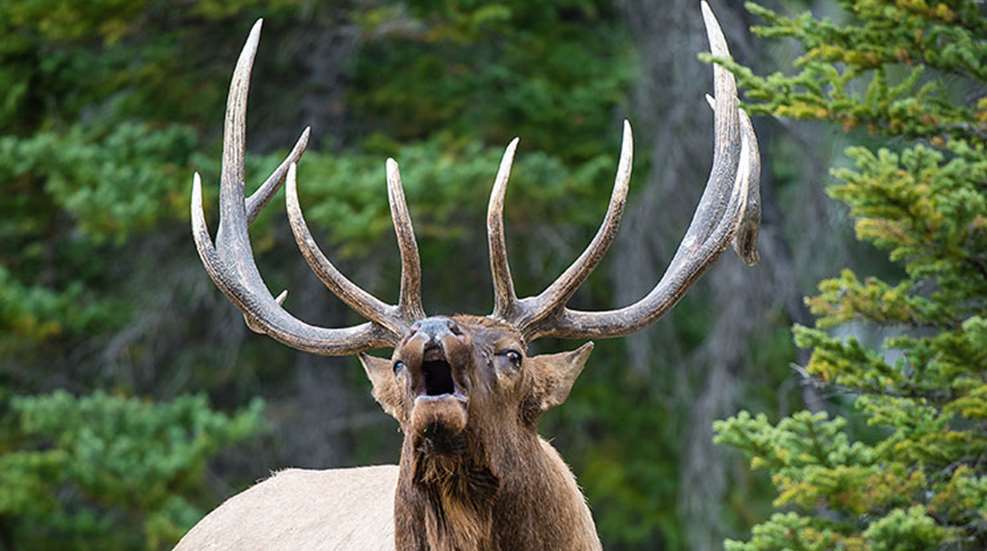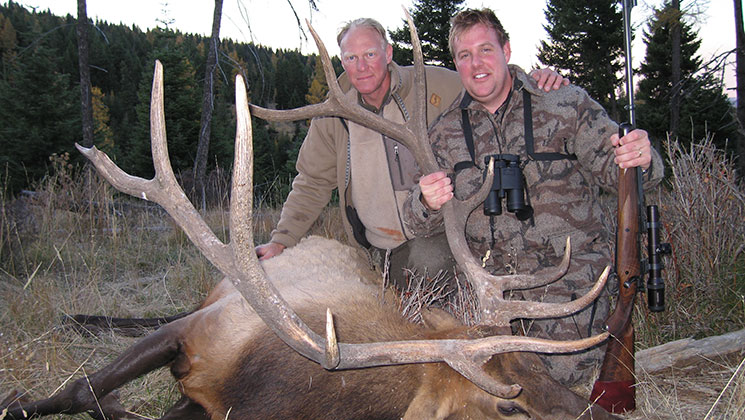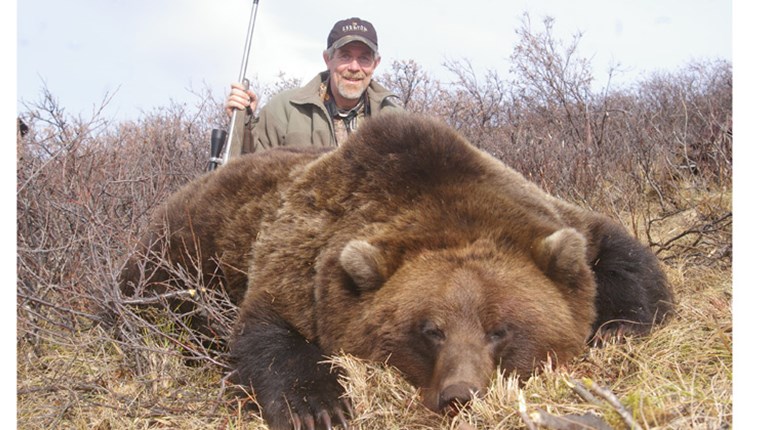
There are few game animals in the world that conjure as much excitement and desire as the elk. He certainly ranks right there with the Cape buffalo and while he lacks the element of danger, the wapiti overshadows the wild cattle with his mountain majesty. He is without doubt a very worthy adversary for any hunter.
Before we hunt him, perhaps a little of his natural history will add to our understanding of and respect for the elk. While today we think of him as purely a denizen of the mountain, the elk is in reality just as much a plains animal. Elk are grazers, and before the intrusion of Europeans in North America they would have been found on the lower foothills and even right out on the plains, especially in winter. In the end, to survive, they evolved to utilize tougher country and heavy timber. Our elk were hunted to near-extinction for their ivory tusks and were even pursued by poachers into their last stronghold, Yellowstone Park. It was only when local citizens declared war on the poachers that the remnant herd was saved. These, some 50,000 animals, formed the core of the breeding-and-release program that repopulated North America with this grand animal. Today elk thrive virtually from coast to coast and from Canada to Arizona.
The annual cycle of the elk is a thing to behold. The bulls shed their antlers in late March and early April, with the new growth beginning literally within hours of the shed. By mid-July the antlers are nearly full size, and elk will rub their velvet during mid-August. At this time a bull elk is all he can be. He is rolling in fat; a big, mature bull can indeed weigh 1,000 pounds or more. The antlers of a mature bull are typically six points on each side and are often 4 feet or more in length. An exceptional bull is a “royal,” or 7x7, and sometimes true monsters happen, with typical antlers of eight, nine or even 10 points on each side. Elk, like other deer, are also prone to nontypical antlers, where wild heads with odd shapes and extreme numbers of points can haunt our dreams. By the 1st of September they are ready for the rut, perhaps the grandest spectacle in the wild world. But we should not get lost in the bulls, for the lady elk are wonderful also.
A cow elk does not have antlers, but she does have the vestigial fangs that are now ivory teeth. She is more slender and much lighter in weight than a bull; most cows weigh around 500 pounds, although I did take an exceptional one that weighed 700 pounds. Cows are very tasty and often are far more challenging to hunt than a bull. Cows are almost never alone and are the leaders of the elk tribe. They are often very old and very wise and difficult, but at the same time their greater numbers, and usually greater number of available tags, make them more accessible.
To hunt elk well, in my opinion, we need to disregard most of the elk-hunting “experts,” and certainly much of the normal hunting practice. Elk calling is highly overrated, and certainly so over-done that many, or even most, bulls will run at the sound of a call, even one in skilled hands. Making a “bugle” almost certainly guarantees failure.
Another common hunting “tactic” that has saved countless elk is pre-hunt scouting. To best understand an elk it is probably useful to consider him the opposite of a whitetail. While the deer will live under your bed and put up with endless human disturbance, a herd of elk will simply leave if disturbed and go to somewhere that is quiet … often miles away. Getting to your camp a few days before season, shooting and tromping through the woods—or worse, zooming around on some ATV—is almost certain to drive most of the elk out of your “scouted” area. Knowing the ground you will hunt is extremely valuable, but learn it a long time before the season (at least weeks before you hunt). When you actually hunt, your greatest advantage is to be quiet as a mouse, camp below the prevailing wind and go into the actual hunting ground only when it counts.
An elk will most likely bed facing downwind, watching where he cannot smell and smelling all he cannot watch. Perhaps only two animals live more by their noses than an elk: the elephant and bear. When you hunt elk, you can make a little noise and perhaps be seen a tiny bit, but any mistake about the air and you are beaten—at a half-mile away or more!
The other complication with elk is they are herd animals. I often hunt herds of 200 or more; it is extremely rare to hunt a lone individual. The sheer numbers of eyes and noses is daunting to overcome. When you combine this with the herd-wisdom that posts sentries, and an overall herd that may be spread out for several hundred yards, you have a formidable opponent. And because they are a communicative herd, you must defeat them all, each and every one, to get a good shot.
I use three basic hunting techniques to take elk. But as with many best-laid plans of mice and men the actual hunt often becomes a combination of all of them, with some “wing-it” thrown in. Whatever you do, live by the wind, stay out of sight and be quiet.
If there are meadows in the area, it is most likely elk will feed into these late in the afternoon and return to the heavily timbered regions early in the morning. Ambushing them on the way to and from these feeding areas can be extremely effective. The key to this is to have a good idea of their route and to be on it, downwind, well before they move. You will usually be able to hear them before you can see them, but at times they will move in perfect silence. At first sign of game, you must become still, perfectly still, as in don’t even blink your eyes. The ancient lead cows, which may have had 30 years’ practice at being an elk, don’t overlook much.
Another very interesting and wonderful way to hunt is to spot and stalk. If you are in varied terrain that allows you to look over some distance, glassing for bedded or feeding elk can be very rewarding. I like to find them at several hundred yards, or even a mile or two away and then plan a stalk. Knowing where they are gives you a great edge as you begin, in contrast to having to hunt randomly, hoping for a chance. By using the ridges, valleys or dense stands of timber as cover, you can bring your hunt to relatively close quarters. Then the chess match begins. You must “find them back”: see them again before they see you, and then locate the bull or other individual you want before you can move into position for a precise hit, all without letting any one of them detect you in any way. The last phase of the stalk is one of the most exciting things you can do. The tension and challenge are tremendous. Essentially this becomes the last kind of hunting: still-hunting.
Pure still-hunting is an art form and without doubt the deadliest kind of hunting. Said quickly it seems very simple: You move through the brush or timber very, very slowly while smelling, hearing and seeing everything in the forest. The pure essence of it is to move in the elk’s world (or any other animal’s world) and to gain sight of them before they detect you. It is not possible to hunt too slowly; in fact, it is almost impossible to make yourself hunt slowly enough. It should take a few hours to go a mile, or at times a few hours to go a few hundred yards; one step at a time with a long pause between moves, a pause that is used to see every leaf, twig, stump and patch of elk hair.
I still-hunt with a powerful binocular, once again flying in the face of “experts” who tell you high magnification is useless in tight places. I use 10x, while my son actually employs 12X! We have a contest each year to see who can find an elk with the least evidence. I hold the record with a whisker glinting in the sun, but the winner usually finds an ear, nose, hoof or a finger-sized bit of hair.
When you have the first clue that they are there, you must freeze and remain motionless until you have assessed all of them. Again, it is highly unlikely that one is alone. There may be five or 500, and you must not alarm them while you locate a clear shot into the one you want.
A slight alteration to regular still-hunting comes when there is snow on the ground. Now you can track them, but it is not as simple as following hoofprints in the snow. Elk, especially big bulls, will often circle downwind of their trail, and/or turn regularly and watch their back trail. To succeed you need to use the same slow, cautious approach and regularly leave the tracks, looping well below the wind from time to time. With luck, enhanced by skill, sometimes you will gain sight of them in reasonable rifle range.
The last phase of a still-hunt, or long stalk, is usually made by crawling. If I can offer you one deadly “tactic” it is crawling. It took years for the elk to teach me how to do it, but once learned at least some crawling accounts for 80 percent or more of the elk we take for ourselves or with clients. (And the success ratio is greater than 90 percent.)
When you finally spot the elk, say within 150 yards or so, you crawl until you have a clear shot; yes, literally crawl right down there like a spider. This has two great advantages. First, you are more difficult to see. Second, if they do see you, they often mistake you for another kind of animal or predator—critters that pose no threat until they are very, very close. Elk will run at the first hint of a human, but are very likely to stand and protest, even threaten the coyote, bear or cougar with their deep “bark.” If you can get them to mistake you for the four-legged predator, you can often get a very good shot.
If you are in a public hunting area, one where the elk are disturbed by human activity, long-range spot-and-stalk probably will not work. If you are hunting big bulls there is always the chance they will hole up somewhere and be vulnerable to still-hunting. But the very best way to get elk in a busy place is to find a heavily traveled area with some good visibility, and simply sit down and wait. We often hear tales of the camp cook getting the meat while the other hunters put in maximum effort. It is usually because he is sitting still somewhere, killing time before supper, when the elk literally stumble over him.
With that, we should go hunting. Generally rifle hunts take place after the rut, when the older bulls are most likely to abandon the women and take up a bachelor’s lifestyle. (At times there is a second run in late October, when the cows that were not bred in September cycle again. Then, against the rules, you may find a big old bull in a herd.) Sometimes they go alone, but it is most likely to find two to 10 in a group.
One morning began with a hard frost and clear skies. We glassed a long open meadow, looking for ghosts in the gray pre-dawn light. They were there, grazing, moving like wraiths at 500 yards. It was much too early to make any judgment about the quality of the antlers, or to try to stalk closer. As the light grew stronger they neared the timber. There was enough light at the time to offer tantalizing news: There was a big old bull among them, a heavy-bodied 6x6. Unfortunately they walked rapidly into the thickets and escaped for the moment. They continued down into the valley, across the stream and up onto a steep slope with its patchy young timber. They, all 10 of them, bedded down about three-quarters of the way to the top of the 500-yard slope, bedded in a thick patch of baby trees where any kind of approach was impossible.
I like birds in the hand and knew exactly where a big trophy bull was, so rather than hunt other areas, or risk any sort of long-odds attack that could spook him out of our hunting area, decided to spend the day on the opposite slope. There, by being very careful not to be seen and being ready to sneak out the back door should the wind change, we could wait for them to feed out in the evening.
The face where the bulls slept would fall into deep shadows about 3 p.m., and this should be their signal to begin their afternoon stroll to water and the night’s feed. If they used the right trail, if they moved the right way, if the big boy moved into an opening, if all of this happened we might get a shot at 200 yards.
They began almost on cue. The young bulls, lesser bulls and also-rans occasionally appeared as fleeting patches of yellow in the fir timber. It is truly amazing just how little it takes to hide an elk, even a herd of hundreds of them. As our fellows began to move about we could watch a bull, in full sight, in a clearing. Watch him, that is, until he vanished for several minutes, only to magically reappear where he had been all along. They moved, nibbled and even seemed to post three young sentinels to watch our part of the mountain.
Our last glimpses were of elk moving into the lower thickets, into a place where hunting them was virtually impossible. It was not that I could not take Scott into the thicket and probably kill a bull, but which bull would it be? We would have been dealing with patches of elk hide, bits and pieces of antler all at powder-burn range. Ultimately we gave up; there was no hope, no chance that was not unreasonably risky. There was little to do except retreat gracefully and hope for tomorrow. I was about to drop down into the stream the bulls had crossed that morning when I gave in to the urge to see the last of the little point of land, a peninsula that fell into the streambeds below. It was risky. Sundown approached and it would be very crowded if we met them, but it seemed like a very good idea at the time.
What began as an “easy” ambush had become a still-hunt of immense difficulty, a very up-close-and-personal one, inches at a time in broken timber, inches at a time into what I hoped was a collision course with the boys. We had gone about 30 yards when a flicker caught my eye—a white flash that seemed out of place, then another and another. With study there was a small forest of ivory in front of us, 10 bulls all with their heads down, feeding on green elk sedge. They were like ships, hull-down on the horizon. We could only see the tops of their sails. From time to time one would lift his head and look, giving us a tantalizing view of 3 or 4 feet of antler … and giving the bull full view of us. If the timing were wrong, if we moved at the moment one scouted his horizon, it was over. But so far so good, and even though once in a while one stared straight at us, our camo facemasks kept us invisible.
The scene in front of us was a mess, a maze of elk, one that I was sure would never offer a clear view let alone a shot at the one we wanted. Then at the front of them, about 50 yards distant, something began to take shape. Two big, wide “v’s” of antler, about 4 feet apart, were moving toward us. It was him! At first I could only make out the fifth and sixth points on each side and the very large space between them, but with each step he gained elevation. Soon the antlers framed the top line of his back and the center of both of his shoulders. I stretched my hand behind me to grasp Scott’s coat and pull him until he was touching my back. Then I lifted the barrel of his .375 onto my shoulder and whispered, “Dead center between his shoulders.”
With the boom and launching a 270-grain Failsafe the world turned into a boiling mass of bull elk. My friend, who had just pulled the trigger, was in momentary almost-panic, for his shot seemed to cause nothing but live, moving bulls. What I saw, which recoil had hidden from him, was the great long antlers simply collapsing. We waited in perfectly still silence until the others had moved away, and then moved forward so he could see his prize.
A bull elk in his prime is simply magnificent. I often wonder which is grander: sable, gemsbok, caribou or elk? Taken as a whole, with his often incredible aspen or tamarack hills, the sound show of the bull and his ladies, on a crisp autumn morning, I suppose there is nothing to compare with him on Earth.





































